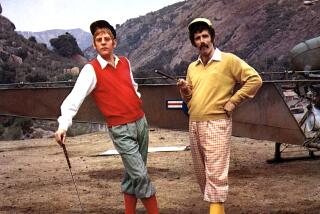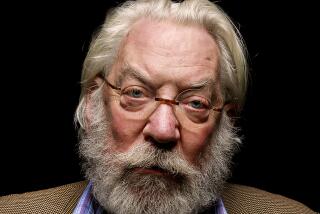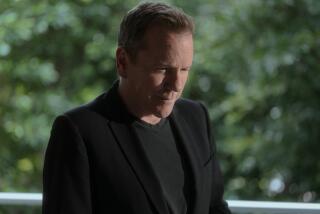These World War II Heroes Were Dirtier by the ‘Dozen’
It is doubtful that soldiers like Victor Franko, Archer Maggott and Vernon Pinkley were whom Tom Brokaw had in mind when he wrote “The Greatest Generation,” his salute to America’s courageous and self-sacrificing World War II veterans. They were convicts whose sentences for brutal crimes ranged from hard labor to death by hanging. But they, too, distinguished themselves in battle, on screen at least, as members of “The Dirty Dozen,” one of the most unconventional war movies ever made.
Warner Home Video has just bestowed on “The Dirty Dozen” the video industry equivalent of a Medal of Honor with the release on VHS ($20) and DVD ($25) of a “special edition” of Robert Aldrich’s 1967 classic. It contains 15 minutes of extra footage, including the original theatrical preview (“Train them! Excite them! Arm them! And turn them loose on the Nazi high command!”), a new introduction to the film with Ernest Borgnine doing his Troy McClure bit (“You may remember me as General Wordon”), and an on-location featurette, “Operation Dirty Dozen.”
“The Dirty Dozen,” Borgnine observes in his intro, “turned the war film inside out.” Released in 1967, it must have struck a chord with protesters of the Vietnam War to hear Borgnine’s character state, “Somebody up there [in the Army’s top brass] must be a stark raving lunatic” to send 12 incorrigible prisoners on a suicide mission behind enemy lines to blow up a Nazi chateau.
Audiences had never been asked to cheer on such a disreputable platoon of misfits--or, as a psychiatrist deems them, “the most twisted, anti-social bunch of psychopathic deformities I have ever run into. You have a religious maniac, one malignant dwarf, two near idiots, and the rest I don’t even want to think about.”
Can you name all 12? Roll call: Charles Bronson as Joseph Wladislaw; Jim Brown as Robert Jefferson; Tom Busby as Milo Vladek; John Cassavetes as Victor Franko; Ben Carruthers as Glenn Gilpin; Stuart Cooper as Roscoe Lever; Trini Lopez as Pedro Jimenez; Colin Maitland as Seth Sawyer; Al Mancini as Tassos Bravos; Telly Savalas as Archer Maggott; Donald Sutherland as Vernon Pinkley; and Clint Walker as Samson Posey.
They are led by Lee Marvin’s “ill-mannered and ill-disciplined” Major John Reisman, who, one character notes, seems to be headed for a court-martial himself.
“Just imagine if it were done today,” pondered David Everitt, co-author of “The Manly Movie Guide” (Boulevard Books), which ranked “The Dirty Dozen” as among the 12 manliest movies ever made. “Who would they put in it: Chris O’Donnell, Ben Affleck, Tobey McGuire, Skeet Ulrich? Oh, jeeze. It’s just about the manliest cast ever assembled, although I wish someone could possibly explain to me how Trini Lopez got in there.”
Simple. Lopez was at the time one of the top entertainers in the world with such hits as “If I Had a Hammer” and “Lemon Tree.” He was recruited by producer Kenneth Hyman.
“When you’re hot, you’re hot,” Lopez said with a laugh in a phone interview. “I wanted to be an actor. I still want to be an actor. I always wanted to be in the movies.”
“The Dirty Dozen” was filmed in England, about 17 miles northeast of London, where the cast members partook of the swinging night life. “I’d be on the set at 7 in the morning,” Lopez recalled, “and Lee, Telly Savalas and John Cassavetes would be driving up in the limo, still in their tuxes [from the night before]. They would put on their fatigues and go right to work. They were wild guys.”
And were it not for some misfired career advice from Frank Sinatra, Lopez just might have been the hero of the film. The script had his character atop the Nazi chateau at film’s end, sacrificing his life to blow it up. But the film’s four-month shooting schedule became a casualty of the inclement weather. It stretched into seven.
Sinatra, who had discovered Lopez in 1962, visited London with bride Mia Farrow and invited Lopez to dinner. “He said he understood that the movie was really behind schedule,” Lopez said. “I asked how he knew that. He said, ‘You know, the public is very fickle and they’re going to forget about you if you don’t go out there and continue with your touring.’ I had been turning down a lot of offers, so I got my attorneys to get me out of the picture.”
Which is why Lopez’s character dies off-screen. His neck is said to be broken after his parachute is hung up in a tree. “I think it was a lemon tree,” he joked.
Donald Sutherland’s luck ran better. The Canadian native had been working in England for 15 years. His film credits included “The Castle of the Living Dead” and “Dr. Terror’s House of Horrors.” Hired as one of “the bottom half of the dozen,” he originally had one line: “Number two, sir.”
But during a rehearsal, Sutherland recalled, Clint Walker raised his hand to discuss a scene in which his character was supposed to impersonate a general. “He put up his hand,” Sutherland said in a phone interview, “and said that he didn’t think [the scene] was proper or correct in keeping with his role as a North American Aboriginal. Aldrich turned around, pointed to me and said, ‘You with the big ears, you do it.’ ”
Vernon Pinkley’s mock-review of troops under the command of Reisman’s nemesis (“They’re very pretty, Colonel, but can they fight?”) is one of the film’s highlights. The comic scene--which, according to Sutherland, one of the producers wanted to cut from the film because “humor had no place in a war film”--would also be a career breakthrough.
He later received a phone call in England from Aldrich’s agent, who told him that “this particular scene has had a lot of success, and that I had a big chance to come to California to capitalize on this scene,” Sutherland said. “I had no money. I phoned [fellow Canadian] Christopher Plummer, who was at Stratford at the time, to ask if I could borrow $1,500 to go to the United States. He said it would be at his lawyer’s office in the morning.”
When he arrived in Hollywood, he was sought out by Ingo Preminger, then a literary agent, who had also been impressed by the scene and gave Sutherland a script for another war film, to be directed by Robert Altman. The film was “MASH.”
“Everyone told me it would be a dreadful film and it would ruin my career,” Sutherland said, laughing. “But I didn’t have a career. I was one of the most fortunate people in the world, thanks to Clint Walker.”
“The Dirty Dozen” earned four Oscar nominations, including best supporting actor for Cassavetes, and it won the Academy Award for best sound effects. It was followed by several made-for-TV sequels and a short-lived TV series, about which the less said the better.
Director Joe Dante offered a more fitting tribute by casting “Dozen” veterans Borgnine, Brown, Walker and George Kennedy as voices of the “Small Soldiers” who go on a rampage. And in the--of all things--romantic comedy “Sleepless in Seattle,” Tom Hanks (future “Saving Private Ryan” squad leader) one-ups a weeping Rita Wilson’s account of “An Affair to Remember” by jokingly confessing that he cried during Jim Brown’s grenade-drop run at “Dirty Dozen’s” explosive end.
According to Everitt, whose newest book with Harold Schechter, “For Reel,” tells the true stories that inspired some of Hollywood’s most popular films, the members of “The Dirty Dozen” should not be excluded in any discussion of the representation of “the greatest generation’s” war effort on film.
“ ‘Saving Private Ryan’ is a solid, manly movie,” he offered, tongue-in-cheek, “and qualifies as that strange sub-species known as the manly tear-jerker. But I think it’s important also to remember the vicious reprobates and psychopathic lowlifes--an important part of that rainbow experience we call manhood.”
More to Read
Only good movies
Get the Indie Focus newsletter, Mark Olsen's weekly guide to the world of cinema.
You may occasionally receive promotional content from the Los Angeles Times.










